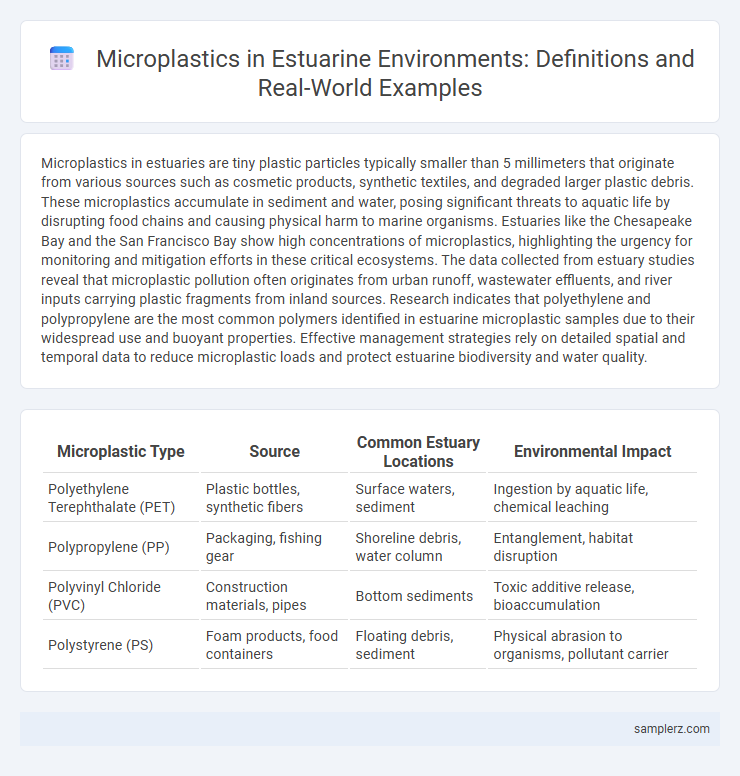Microplastics in estuaries are tiny plastic particles typically smaller than 5 millimeters that originate from various sources such as cosmetic products, synthetic textiles, and degraded larger plastic debris. These microplastics accumulate in sediment and water, posing significant threats to aquatic life by disrupting food chains and causing physical harm to marine organisms. Estuaries like the Chesapeake Bay and the San Francisco Bay show high concentrations of microplastics, highlighting the urgency for monitoring and mitigation efforts in these critical ecosystems. The data collected from estuary studies reveal that microplastic pollution often originates from urban runoff, wastewater effluents, and river inputs carrying plastic fragments from inland sources. Research indicates that polyethylene and polypropylene are the most common polymers identified in estuarine microplastic samples due to their widespread use and buoyant properties. Effective management strategies rely on detailed spatial and temporal data to reduce microplastic loads and protect estuarine biodiversity and water quality.
Table of Comparison
| Microplastic Type | Source | Common Estuary Locations | Environmental Impact |
|---|---|---|---|
| Polyethylene Terephthalate (PET) | Plastic bottles, synthetic fibers | Surface waters, sediment | Ingestion by aquatic life, chemical leaching |
| Polypropylene (PP) | Packaging, fishing gear | Shoreline debris, water column | Entanglement, habitat disruption |
| Polyvinyl Chloride (PVC) | Construction materials, pipes | Bottom sediments | Toxic additive release, bioaccumulation |
| Polystyrene (PS) | Foam products, food containers | Floating debris, sediment | Physical abrasion to organisms, pollutant carrier |
Introduction to Microplastics in Estuarine Environments
Microplastics, tiny plastic particles less than 5 millimeters in size, are pervasive pollutants in estuarine environments, originating from sources such as urban runoff, wastewater discharge, and degraded larger plastics. These particles accumulate in estuary sediments and water columns, impacting aquatic organisms through ingestion and habitat disruption. Monitoring microplastic concentrations in estuaries reveals significant spatial and temporal variability influenced by hydrodynamics, anthropogenic inputs, and seasonal cycles.
Sources of Microplastic Pollution in Estuaries
Microplastic pollution in estuaries primarily originates from urban runoff carrying microbeads from personal care products, synthetic fibers released during laundry processes, and fragmented plastic debris from packaging waste. Industrial discharges and wastewater treatment plants also contribute significant amounts of microplastics into estuarine waters. Agricultural activities introduce microplastic contaminants through the use of plastic mulching films that degrade and enter sediment and water systems.
Common Types of Microplastics Found in Estuaries
Common types of microplastics found in estuaries include polyethylene (PE), polypropylene (PP), and polystyrene (PS) fragments originating from consumer products and packaging materials. Microbeads from personal care products and synthetic fibers shed from clothing extensively contribute to microplastic pollution in these ecosystems. These microplastics pose significant threats to estuarine wildlife through ingestion and habitat contamination.
Pathways of Microplastic Entry Into Estuarine Systems
Microplastics enter estuarine systems primarily through riverine discharge carrying urban runoff, wastewater effluents, and stormwater overflow, transporting synthetic fibers, fragments, and microbeads. Atmospheric deposition also contributes microplastic particles from industrial emissions and tire wear, settling into estuaries via precipitation. Furthermore, direct littering and aquaculture activities introduce microplastic pellets and broken-down plastic debris, exacerbating pollution levels in these transitional coastal zones.
Microplastic Contamination in Sediments and Water Columns
Microplastic contamination in estuary sediments and water columns significantly impacts aquatic ecosystems, with particles originating from synthetic fibers, microbeads, and fragmented larger plastics. Studies reveal concentrations ranging from hundreds to thousands of particles per kilogram of sediment and several particles per liter in water columns, disrupting nutrient cycles and harming benthic organisms. Monitoring these pollution levels is critical for assessing ecological risks and developing effective mitigation strategies in estuarine environments.
Impacts of Microplastics on Estuarine Wildlife
Microplastics in estuaries, such as polyethylene beads from personal care products and fragmented plastic packaging, pose significant threats to estuarine wildlife. These particles are ingested by organisms like fish, crustaceans, and bivalves, leading to physical blockage, reduced feeding efficiency, and exposure to toxic chemicals. Chronic microplastic contamination disrupts reproductive systems and bioaccumulates through food webs, ultimately affecting biodiversity and ecosystem health.
Microplastic Accumulation in Estuarine Food Webs
Microplastic accumulation in estuarine food webs occurs through ingestion by filter-feeding organisms such as bivalves and zooplankton, which serve as primary conduits for microplastic transfer to higher trophic levels. Studies reveal that fish and crustaceans in estuaries exhibit microplastic particles in their digestive systems, indicating bioaccumulation and potential biomagnification along the food chain. These persistent microplastics pose significant ecological risks, including physical harm and chemical contamination, disrupting estuarine biodiversity and ecosystem function.
Case Studies: Reported Microplastics in Selected Estuaries
Reported microplastic concentrations in estuaries such as the Chesapeake Bay and the Yangtze River Estuary reveal significant pollution levels, with fibers and fragments comprising up to 85% of collected particles. Studies indicate microplastic densities ranging from 0.1 to 5 particles per liter, highlighting the impact of urban runoff and wastewater discharges. These case studies underscore the urgent need for improved waste management and pollution control strategies in estuarine environments.
Methods for Detecting Microplastics in Estuarine Samples
Methods for detecting microplastics in estuarine samples include Fourier Transform Infrared Spectroscopy (FTIR), which identifies polymer types by their unique spectral fingerprints, and Raman spectroscopy that offers high spatial resolution for particle characterization. Density separation using saline solutions isolates microplastics based on buoyancy differences, while microscopic analysis combined with staining techniques enables visual identification and quantification. Advanced techniques such as pyrolysis-GC/MS provide detailed chemical composition data, enhancing the accuracy of microplastic detection in complex estuarine matrices.
Strategies for Reducing Microplastic Pollution in Estuarine Areas
Estuarine areas face significant microplastic pollution from urban runoff, wastewater discharge, and industrial activities, necessitating targeted strategies for reduction. Implementing advanced filtration systems in wastewater treatment plants captures microplastics before they enter aquatic ecosystems, while restoring natural vegetation buffers along shorelines helps trap debris and reduce surface runoff. Promoting public awareness campaigns and enforcing stricter regulations on plastic waste disposal significantly decrease microplastic inputs in estuarine habitats.

example of microplastic in estuary Infographic
 samplerz.com
samplerz.com